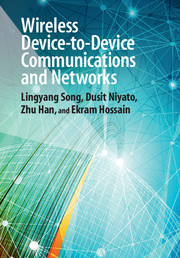Book contents
- Frontmatter
- Dedication
- Contents
- Preface
- Part I Introduction
- Part II Techniques for modeling and analysis of D2D communications
- Part III Resource management, cross-layer design, and security for D2D communications
- 4 Mode selection and resource allocation for D2D communications underlaying cellular networks
- 5 Interference coordination for D2D communications
- 6 Subchannel allocation and time-domain scheduling for D2D communications
- 7 Cross-layer design for device-to-device communication
- 8 Security for D2D communications
- Part IV Applications of D2D communications
- Part V Standardization of D2D communications
- References
- Index
6 - Subchannel allocation and time-domain scheduling for D2D communications
from Part III - Resource management, cross-layer design, and security for D2D communications
Published online by Cambridge University Press: 05 March 2015
- Frontmatter
- Dedication
- Contents
- Preface
- Part I Introduction
- Part II Techniques for modeling and analysis of D2D communications
- Part III Resource management, cross-layer design, and security for D2D communications
- 4 Mode selection and resource allocation for D2D communications underlaying cellular networks
- 5 Interference coordination for D2D communications
- 6 Subchannel allocation and time-domain scheduling for D2D communications
- 7 Cross-layer design for device-to-device communication
- 8 Security for D2D communications
- Part IV Applications of D2D communications
- Part V Standardization of D2D communications
- References
- Index
Summary
Since the co-channel interference between cellular and D2D links causes performance degradation, resource management is necessary for D2D communications underlaying cellular networks. This chapter introduces the subchannel allocation and time-domain scheduling schemes, which improve the system performance effectively.
Subchannel allocation
Note that, with regard to the underlay approach, to mitigate cross- and co-layer interference, there would be a central entity in charge of intelligently telling each cell which subchannels to use. This entity would need to collect information from the D2D users, and use it to find an optimal or at least a good solution within a short period of time. The presence of a large number of D2D users, and the allowance for the coexistence of multiple D2D users with cellular users, makes the optimization problem too complex. Additionally, latency issues arise when trying to facilitate the communication of femto cells with the central subchannel broker throughout the backhaul. A distributed approach to mitigate cross- and co-layer interference, whereby the D2D users can manage their own subchannels, is thus more suitable in this case (i.e., self-organization). In a noncooperative solution, i.e., a self-organized approach, each D2D user would planits subchannels so as to maximize the throughput and QoS for its users. Furthermore, this would be done independently of the effects its allocation might cause for co-channel D2D and cellular users, even if this implies greater interference. The access to the sub-channels then becomes opportunistic, and it is possible that the method decays to greedy. By contrast, in a cooperative approach (the network-assisted approach), the D2D users can gather partial information about the subchannel usage situation and may perform its allocation taking into account the effect this would have on co-channel neighbors. In this way, the average cellular and D2D users' throughput and QoS, as well as their global performance, can be locally optimized.
6.1.1 Centralized (operator-managed) subchannel allocation
An innovative resource-allocation scheme is proposed to improve the performance of a mobile peer-to-peer, i.e., D2D communication, system as an underlay in downlink (DL) cellular networks.
- Type
- Chapter
- Information
- Wireless Device-to-Device Communications and Networks , pp. 173 - 204Publisher: Cambridge University PressPrint publication year: 2015



